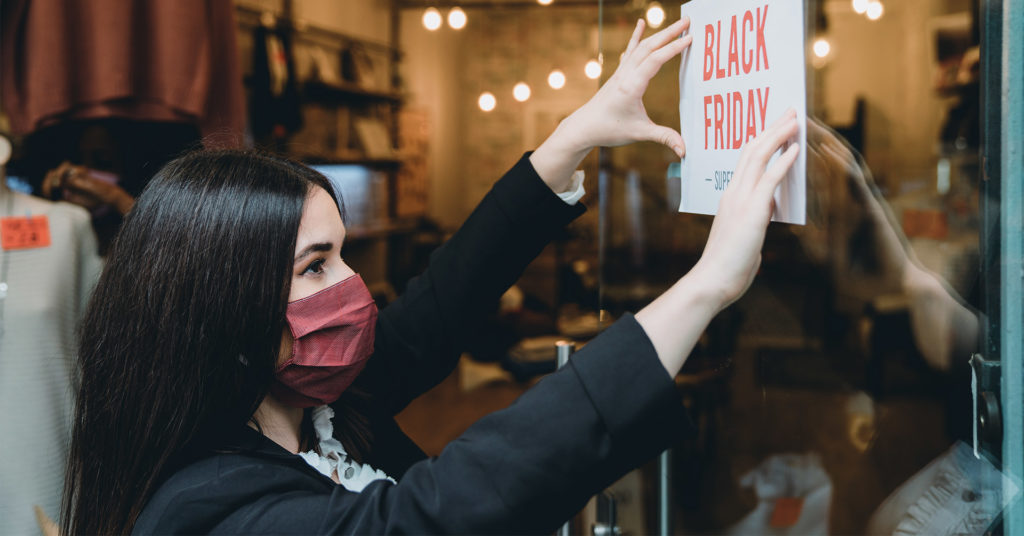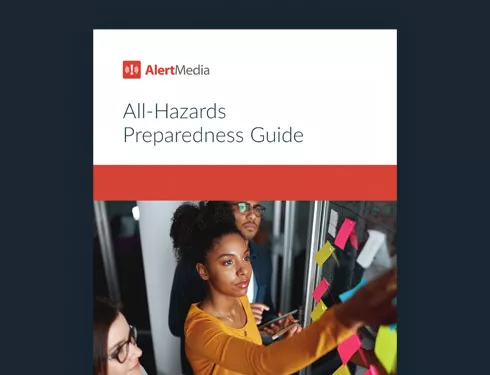
Retail Holiday Preparedness: How to Protect Your People and Business
In this post, we discuss retail holiday preparedness strategies and why the upcoming holiday shopping season will be unlike any other.

The 2020 holiday season proved to be unlike any other in recent years, with many consumers choosing to take advantage of online sales instead of shopping in stores for both convenience and safety. But this year will also be unique—for some of the same reasons and several new ones. For one, retailers continue to deal with several very real, “offline” challenges due to the ongoing COVID-19 pandemic, including numerous bottlenecks in the global supply chain that have driven up product sourcing costs. Second, a tighter labor market has complicated hiring efforts. In their search for candidates, retailers have had to respond by increasing wages or offering bonuses and other incentives like tuition reimbursement—a first for many.
But operational pressures from the supply chain and labor crisis aren’t the only thing taxing retailers right now. They must also consider keeping their employees and businesses safe, especially during a year when many customers plan to return to shopping in brick-and-mortar stores and malls. COVID cases may be declining across the U.S., but in-store workers are still at increased risk for exposure to the virus alongside all the other potential threats during the holiday season shopping bump.
Retailers can take extra precautions by understanding what the 2021 holiday season might look like and putting a preparedness plan in place that prioritizes business continuity and employee workplace safety.
Download Our All-Hazards Preparedness Guide
What to Expect This Holiday Season
According to the National Retail Federation, we’re likely to see record-breaking holiday sales this year, even as global supply chain issues drive up prices for goods. A recent study by Mastercard predicted U.S. retail sales will grow 7.4 percent compared with 2020.
A variety of factors point to sales increases, including the fact that many consumers’ incomes have risen over the past year. Additionally, consumers say they feel increasingly safe shopping in-store this year versus through ecommerce. A recent Shoptick survey found that 43 percent of consumers plan to make most of their holiday purchases in-store, up nine percent from last year. But they’re also getting started a lot earlier to avoid the holiday rush, shipping delays, and supply shortages.
“The U.S. retail industry expects a shortage of approximately 350,000 workers heading into the 2021 holiday shopping season.”
Consumers may be ready to shop, but retailers aren’t quite prepared to handle the additional foot traffic from the busiest time of the year. Retail workers are quitting at record rates, and the U.S. retail industry expects a shortage of approximately 350,000 workers heading into the 2021 holiday shopping season. Those who end up working during the holidays won’t have as much peer or management support as in years past.
Retailers have responded by offering discounts usually reserved for Black Friday throughout the entire month of November, hoping that early access will minimize single-day crowds. But the risks facing retailers during the holidays will abound, Black Friday or not.
Top 4 Risks During the Holiday Shopping Season
With tensions high and staffing low, the ability to keep employees safe will become more difficult. In addition to heightened risks around COVID-19, many other dangers also increase during the holiday shopping season.
Shoplifting
With such big crowds, shoplifting is harder to detect on Black Friday and throughout November and December. One study found 46 percent of U.S. retail theft occurs during the winter months, with 81 percent of that occurring during the holiday period. Beyond the increase in foot traffic, face masks introduced as part of COVID-19 safety measures may make it harder to identify suspicious shoppers.
While the direct impact of shoplifting may be a decline in profits, it also heavily affects employee morale at a time when stress is already high. If shoplifting should occur in your store, expect employees to be more anxious and paranoid as a result.
Cyberattacks
The holiday season also leads to an increase in ecommerce sales, which attracts hackers and cybercriminals who know how to steal credit card numbers, payment details, and other customer data. Beyond the threat of identity theft to consumers, holiday retailers might experience business interruptions from ransomware and other cyber attacks. Especially on Cyber Monday, one of the busiest online shopping days of the entire year, cyber thieves employ numerous tactics in an attempt for financial gain. You can almost certainly expect more phishing emails sent to your employees and attacks on third-party IT systems.
Customer violence
The promise of never-before-seen discounts and opportunities to save big sometimes results in misbehavior from shoppers, especially on Black Friday. In turn, nearly every year, we hear stories of customer violence, injuries, and police intervention. In previous years, retailers have responded by adding more space between checkout areas or staffing the front of stores with security guards or customer experience associates. Still, the threat of violence against retail workers remains something to prepare for.
Traffic & road accidents
With so many people on the road, the potential for vehicle accidents and traffic jams increases. Progressive Insurance found accidents increase by 34 percent on Black Friday in a study conducted a few years ago. A poll from the National Safety Council found that 66 percent of drivers say they allow themselves to be distracted while driving in parking lots during the holidays. In addition to distracted driving, accidents tend to occur due to road rage, fatigued driving, and impaired driving. And shoppers aren’t the only ones who may experience the consequences. Your employees who have to travel to your store for their shifts may encounter any number of these dangerous driving behaviors, putting them at increased risk of injury or worse.
Read our interview with Jim Mires, Vice President of Loss Prevention and Safety at Sally Beauty, to learn how his team protects lone workers and achieves alignment on the company’s safety culture from the top down.
How to Stay Safe During the Holiday Shopping Season
Even though risks increase during the holiday shopping season, the good news is that there are several steps retailers can take to protect their employees and businesses. In addition to being extra vigilant and staffing stores with extra security, the following tips will help you plan and prepare for anything that might go wrong.
Identify all possible risks
The first step in preparing for the holiday season requires understanding each of the unique risks that may face your business. Most retail businesses face the threats outlined above, but the winter months also bring inclement weather that might prohibit your employees from making it into the store or put them in additional danger while on the road.
That’s why we recommend making a list of all possible situations that could occur over the holidays. Discuss these risks with other stakeholders, and rate them based on probability and severity. If a risk has a low probability and low severity, making a plan to mitigate it should be low on your priority list. The opposite would be true for a risk that has a high probability and high severity. Most importantly, you need to know what to expect for all possible risks and how they will impact your business and people.
Create an emergency response plan
Having an emergency response plan will help you and other key stakeholders understand the steps you need to take before, during, and after an incident. Depending on the potential risks you identified, your response to each will be different. Still, the goal remains the same: to minimize impact to both your business and your employees.
Black Friday and Cyber Monday bring a unique set of challenges and issues compared to other times of the year, and your emergency response plan should acknowledge this. From large crowds to theft, make sure you outline how your employees should respond, whether they’re working at a retail location or from corporate headquarters. Document who will be responsible for communicating the next steps should an incident occur, and ensure everyone knows who to go to for questions and answers.
Lastly, because this holiday season might look different from previous years, keep your emergency response plan flexible. As you encounter new situations, ask employees for their reactions and record what you learned within your plan to better address a similar situation in the future.
Leverage real-time threat data
The ability to rapidly identify, verify, and respond to any risks facing your business is critical for retail worker safety. However, it’s often impossible to conduct around-the-clock, manual monitoring of events occurring near all of your store locations and employees without severely constraining company resources. That’s why it’s helpful to integrate a modern threat intelligence solution into your organization so you can more easily identify impacted locations and employees and make them aware of oncoming threats in real-time.
A threat intelligence solution quickly identifies relevant threats, gathers important context, and weeds out misinformation to garner an understanding of the threat severity and how it might impact individuals and store locations.
Additionally, with numerous retail locations spread out across the U.S. that may each face different threats, consider integrating employee data from an HRIS or Active Directory so that you tie threat intelligence to static or dynamic locations to know who might be impacted. This will be especially important for lone workers who may not have immediate access to a supervisor should an emergency take place.
Properly equip your lone workers
Speaking of lone workers, not every one of your employees will have the benefit of working with peers, especially during a year with massive labor shortages. It’s up to you, the employer, to make sure they are adequately protected no matter their work situation.
To minimize risks while working alone, consider lone worker safety technology, such as a personal safety device to enable an employee to call for help quickly and easily, sometimes directly via their cell phones through a mobile app. A “hands-free” app or panic button should immediately place your lone worker in touch with someone at your company or law enforcement and enable GPS tracking to pinpoint their exact location.
Prioritize communication
Lastly, it would help if you had the ability to rapidly communicate with your employees during the holidays. Schedules may change, customers may get irritable if they find items out of stock, and winter weather can close roads or impact travel, and you’ll need a way to reach those impacted quickly and efficiently.
Phone trees, walkie-talkies, or even loudspeaker announcements may not be fast enough or may not be able to cut through the noise effectively. Instead, you might consider an emergency communication solution that allows you to communicate with staff through multiple channels like email, phone, text, social media, or mobile app. Your tool should also include an option for two-way communication, allowing employees to respond to notifications or signal for help if needed—a feature that will be especially important during last-minute customer rushes.
In Conclusion
With Thanksgiving, Christmas, and another busy holiday season rapidly approaching, now is the time to identify and address the main threats to your workers and business. By having the right technology in place, like AlertMedia’s emergency communication software and threat intelligence monitoring, you’ll be better prepared to help your employees perform their jobs both safely and without interruption.




